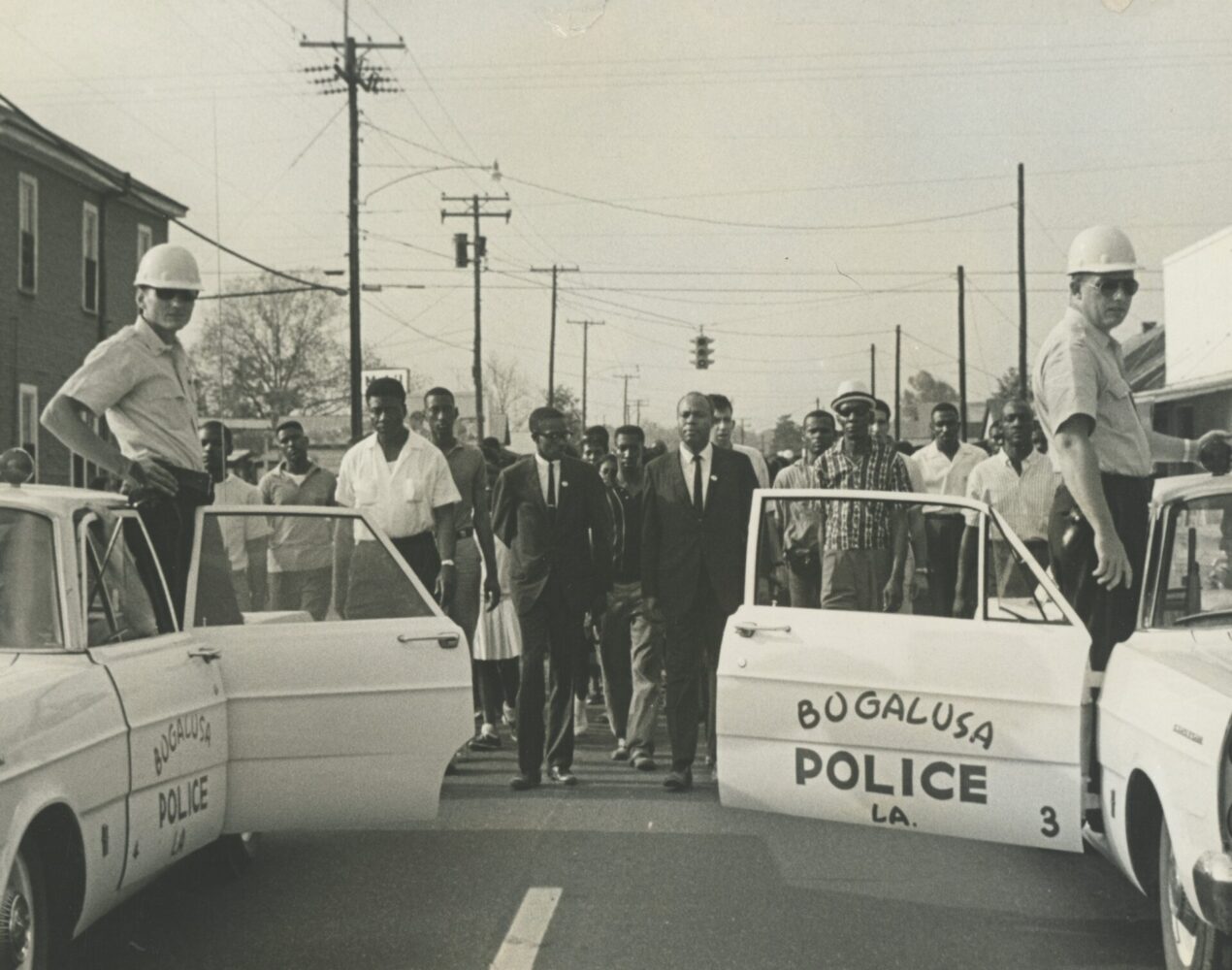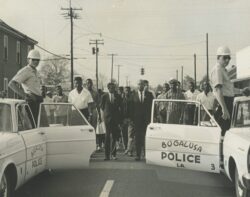Deacons for Defense and Justice
Founded in Jonesboro in 1964, the Deacons for Defense and Justice (DDJ) was a Black self-defense organization that protected local civil rights activists.

Ronnie Moore Papers, Amistad Research Center
Bogalusa Civil Rights March. Front row, left to right: Student activist Don Lampton (behind police officer), Bogalusa Civic and Voters League President and Deacons for Defense and Justice member A. Z. Young, CORE Field Secretary Ronnie Moore, CORE Director James Farmer, Deacons for Defense and Justice member R. T. Young, and an unidentified man.
The Deacons for Defense and Justice (DDJ) was a Black self-defense organization that protected civil rights activists and Black communities in Louisiana during the 1960s. It was founded in 1964 in Jonesboro in Jackson Parish after the Ku Klux Klan and other white supremacists used violence to intimidate members of the civil rights organization Congress of Racial Equality (CORE) as well as local activists. Between 1964 and 1966 seventeen DDJ chapters or affiliates were established in the South. The DDJ gained nationwide fame in 1965, when its Bogalusa chapter clashed with the Ku Klux Klan amid tensions caused by nonviolent demonstrations against racial discrimination. By 1968, however, the DDJ was no longer active.
Jonesboro
The DDJ’s armed activities began in the small town of Jonesboro. In June 1964 CORE organizers and local Black activists launched nonviolent demonstrations and voter registration campaigns to challenge Jim Crow and disenfranchisement. White residents and the area’s Ku Klux Klan responded with threats and violent intimidation. Consequently, several armed Black men began to protect CORE’s local office. When Klansmen paraded through Jonesboro’s Black neighborhood in July 1964, the informal protective squad created an official defense unit to stop white supremacist terror. The organization was ultimately called Deacons for Defense and Justice.
Unlike informal Black self-defense groups that emerged in Louisiana and elsewhere before 1964, the DDJ became a sophisticated and disciplined organization. Its president was a stockroom worker named Percy Lee Bradford; its co-founder, Earnest Thomas, was a mill worker and handyman. The organization’s membership was composed primarily of working-class military veterans, in part because they knew how to handle guns and were familiar with the military-style structure of the organization. Bradford and Thomas preferred married men who were registered voters and rejected applicants known to be hot-tempered. In Jonesboro, armed members of the self-defense group guarded CORE’s office, patrolled the Black neighborhood, protected civil rights meetings, and provided escorts for activists who worked in Jackson Parish. Ultimately the DDJ’s armed activities put an end to both Klan intimidation and racist harassment in Jonesboro.
Bogalusa and Beyond
With the establishment of a Bogalusa chapter in Washington Parish in early 1965, the DDJ gained national fame and notoriety. As with Jonesboro the Bogalusa chapter protected CORE activists and the city’s Black community against racial terror and intimidation. They also protected nonviolent demonstrations. Although armed protection was its primary purpose, the DDJ became an enormous source of pride because its members dared to challenge racist myths of Black submissiveness and contentment. Members regarded their activities as an important affirmation of Black manhood and citizenship.
In April 1965, when nonviolent demonstrations exacerbated racial tensions in Bogalusa, a shoot-out between Klansmen and DDJ members thrust the defense squad into the national spotlight, which prompted white journalists to voice concerns about the organization’s impact on the nonviolent movement. Despite the passage of the Civil Rights Act of 1964, Bogalusa’s white authorities refused to desegregate public facilities and end discriminatory employment practices. In response CORE and local activists staged several nonviolent demonstrations to put pressure on white segregationists, which raised racial tensions. During one demonstration, which took place in July 1965, Henry Austin, a twenty-one-year-old DDJ member, shot a white man named Alton Crowe, who had attacked Black protestors. Crowe survived the shooting, but the violent confrontation shocked white authorities. The FBI feared that the DDJ might even spark a race war and launched a large-scale investigation into its activities.
While the DDJ challenged CORE’s commitment to nonviolence, the organization understood the protest strategy’s tactical usefulness and worked alongside nonviolent activists. In public CORE’s leadership tried to assure white critics that its members remained committed to passive resistance. Privately, however, field workers welcomed DDJ support and acknowledged that the self-defense unit enhanced the effectiveness of nonviolent protest in Bogalusa. Ultimately the combination of nonviolent protests and violent standoffs between the DDJ and white segregationists pressured President Lyndon B. Johnson’s administration to dispatch a Justice Department mediator to the city to end the political impasse.
The DDJ expanded in 1965 and 1966, establishing seventeen chapters or affiliates in the South and four in the North. However, it never became the type of large-scale armed threat that the FBI feared. Media accounts and DDJ leaders put the organization’s membership at several thousand in fifty or more chapters across the South. However, the actual number was never larger than several hundred, and the DDJ only established three official chapters in Louisiana. The difficulty of determining how many Black people joined the DDJ stemmed in part from its secretive nature but also from the fact that the DDJ deliberately inflated membership numbers to unsettle the Ku Klux Klan and other white supremacists.
Last Years of the Deacons for Defense and Justice
The group stayed in the national spotlight throughout 1966, when it protected the famous James Meredith March Against Fear through Mississippi following the shooting of activist James Meredith. In June Meredith had launched a one-person protest to encourage Black Mississippians to overcome their fear of registering to vote, but he was shot by a white segregationist on the first day of his march. CORE, civil rights leader Martin Luther King Jr.’s Southern Christian Leadership Conference, and the Student Nonviolent Coordinating Committee vowed to continue the protest march. After tense discussions the organizers invited the DDJ to prevent additional racist attacks.
By 1968, however, the DDJ had outlived its usefulness. The Civil Rights Act of 1964 and the Voting Rights Act of 1965 had put an end to the most egregious forms of racial segregation and disfranchisement, while white authorities finally provided protection for nonviolent protestors. After the James Meredith March, armed self-defense took on renewed significance in the emerging Black Power movement. The Black Panther Party, in particular, transformed armed resistance into a major pillar of the Black freedom struggle in the late 1960s and early 1970s. Even though the DDJ was influenced by the militant rhetoric of the Black Power movement, it did not become part of it and gradually scaled down operations. In 1967 the Bogalusa DDJ continued to patrol the city’s Black neighborhood and guarded a last round of nonviolent demonstrations. However, by the end of that year, they no longer held official meetings. In the spring of 1968, the FBI determined that the organization and affiliated chapters were no longer active.
Though active for less than a decade, the DDJ helped Louisiana’s freedom movement survive in the face of white supremacist violence, instilled pride in many Black activists, and sometimes served as an additional means of coercion in the fight against Jim Crow.
